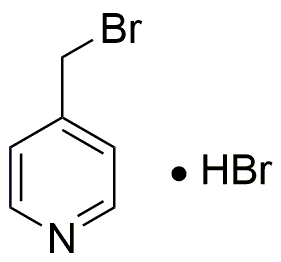4-(Bromomethyl)pyridine hydrobromide is widely utilized in research focused on:
- Synthesis of Pharmaceuticals: This compound serves as an important intermediate in the synthesis of various pharmaceutical agents, particularly those targeting neurological disorders.
- Development of Agrochemicals: It is used in the formulation of agrochemicals, enhancing the effectiveness of pesticides and herbicides, which can lead to improved crop yields.
- Material Science: The compound is applied in the development of new materials, particularly in creating polymers with specific properties, such as increased thermal stability.
- Biochemical Research: Researchers utilize it in studies related to enzyme inhibition and receptor binding, contributing to the understanding of biochemical pathways.
- Organic Synthesis: It plays a crucial role in organic synthesis as a building block for creating more complex molecules, offering versatility in chemical reactions.
General Information
Properties
Safety and Regulations
Applications
4-(Bromomethyl)pyridine hydrobromide is widely utilized in research focused on:
- Synthesis of Pharmaceuticals: This compound serves as an important intermediate in the synthesis of various pharmaceutical agents, particularly those targeting neurological disorders.
- Development of Agrochemicals: It is used in the formulation of agrochemicals, enhancing the effectiveness of pesticides and herbicides, which can lead to improved crop yields.
- Material Science: The compound is applied in the development of new materials, particularly in creating polymers with specific properties, such as increased thermal stability.
- Biochemical Research: Researchers utilize it in studies related to enzyme inhibition and receptor binding, contributing to the understanding of biochemical pathways.
- Organic Synthesis: It plays a crucial role in organic synthesis as a building block for creating more complex molecules, offering versatility in chemical reactions.
Documents
Safety Data Sheets (SDS)
The SDS provides comprehensive safety information on handling, storage, and disposal of the product.
Product Specification (PS)
The PS provides a comprehensive breakdown of the product’s properties, including chemical composition, physical state, purity, and storage requirements. It also details acceptable quality ranges and the product's intended applications.
Certificates of Analysis (COA)
Search for Certificates of Analysis (COA) by entering the products Lot Number. Lot and Batch Numbers can be found on a product’s label following the words ‘Lot’ or ‘Batch’.
*Catalog Number
*Lot Number
Certificates Of Origin (COO)
This COO confirms the country where the product was manufactured, and also details the materials and components used in it and whether it is derived from natural, synthetic, or other specific sources. This certificate may be required for customs, trade, and regulatory compliance.
*Catalog Number
*Lot Number
Safety Data Sheets (SDS)
The SDS provides comprehensive safety information on handling, storage, and disposal of the product.
DownloadProduct Specification (PS)
The PS provides a comprehensive breakdown of the product’s properties, including chemical composition, physical state, purity, and storage requirements. It also details acceptable quality ranges and the product's intended applications.
DownloadCertificates of Analysis (COA)
Search for Certificates of Analysis (COA) by entering the products Lot Number. Lot and Batch Numbers can be found on a product’s label following the words ‘Lot’ or ‘Batch’.
*Catalog Number
*Lot Number
Certificates Of Origin (COO)
This COO confirms the country where the product was manufactured, and also details the materials and components used in it and whether it is derived from natural, synthetic, or other specific sources. This certificate may be required for customs, trade, and regulatory compliance.


